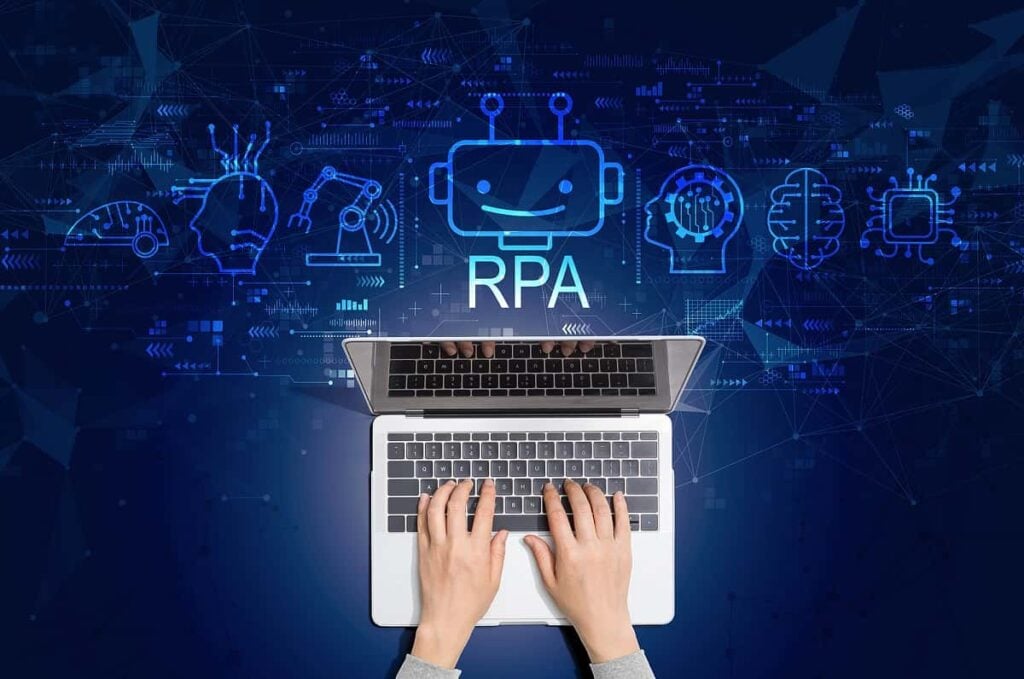Robotic Process Automation From Blue Prism
Table of contents
Table of contents

Japan is an interesting place, with many things happening that most people don’t hear much about. Take for example, the legendary tanuki. It’s a dog-like raccoon-looking thing which roams the forests of Japan, carrying a set of testicles so large, that it uses them like a drum set to communicate with other tanuki. While the whole giant testicles thing is a myth, the tanuki does actually exist in the forests of Japan. If you’re lucky, you might see one while playing a game of shogi, a Japanese version of chess, which was recently mastered by a Japanese artificial intelligence (AI) company called Heroz. Just this past week, Heroz debuted their shares on the Japanese stock exchange leading to tenfold jump in share price on the first day of trading, with hype levels surpassing even those seen in the dot-com boom.

Seems like many developed countries are starting to jump on the artificial intelligence bandwagon, and it’s leading to increased interest from retail investors as to how we all might be able to invest in the AI theme – aside from buying some more shares of Nvidia. However, other opportunities are popping up, as companies now see AI as a must-have to compete, companies like Pega.
We recently wrote about a company called Pegasystems which is using Robotic Process Automation (RPA) as a way for AI to start automating the more mundane aspects of white collar jobs. Now we’re going to take a look at another company across the pond that’s doing much the same thing.
About Blue Prism (PRSM)
Founded in 2001, London-based company Blue Prism (PRSM) took in $59 million in funding before deciding to go public in March of 2016, trading on the London Stock Exchange under the ticker PRSM. We first came across the company in our article on Artificial Intelligence in Business Process Automation where we noted that since their IPO, shares of PRSM have risen over +1,000% giving the company a present day market cap of around $1.66 billion. This rapid share price appreciation is a cause for concern based on something we refer to as “financial market efficiency“.
According to some fellow named Eugene Fama, an efficient financial market is “one in which prices always fully reflect available information”. Are we to believe that in just two years’ time, enough new information was made available to justify a tenfold increase in Blue Prism’s share price? Who knows, but revenues for this “small” company surely took off in 2017:

As we mentioned before, Blue Prism is in the business of “robotic process automation” which entails building software robots that can do things better than John in Mumbai, and at a fraction of the price. Just look at this example taken from an article by the Economist:
Blue Prism’s robots cost at most $15,000 a year. They can perform only routine, rules-driven tasks, but there are plenty of those about. One telecoms company replaced 45 offshore employees, costing a total of $1.35m a year, with ten of Blue Prism’s software robots, costing $100,000. The telecoms firm then spent its savings of $1.25m on hiring 12 new people to do more innovative work locally at its headquarters.
Companies like Blue Prism that use technology to generate cost savings for other companies are a sweet spot right now. That’s because when the recession we’ve all been waiting for finally happens, companies will go into full blown cost savings mode to increase earnings-per-share since revenue growth will stall. RPA solutions will sell like hotcakes no matter what direction the market takes. Just look at this slide:

Now the first thing you might notice is that this diagram is riddled with acronyms. That’s because it was written by a bunch of MBAs who will soon be replaced by the same AI algorithms they write about today. Fortunately, we have some MBAs on staff who can interpret this for us.
“Total Economic Impact” simply refers to a bunch of numbers that you can use to impress your boss within your next performance review. In this case, you would have spent $15 million upfront buying Blue Prism software robots. Over the next three years, you would save over $49 million in overall labor costs, meaning it would only take 15 months before you recouped your initial investment. After three years, the cost savings would equate to $34.3 million in today’s dollars. We call that a “net present value” which means that generally speaking, you’re losing $34.3 million by not spending $15 million today.
What should be blatantly obvious by now is that this solution sells itself when you start whipping out slides like the one above in front of cost-conscious CTOs. That’s why Blue Prism is growing so fast. All the success they’re having in upselling means that their clients see how effective these tools are and want to buy more. We’re talking some big-name customers too, like Coca-Cola, Pfizer, Prudential, Sony, and Walgreens. Brue Prism’s software robots are industry agnostic, and can be used in just about any company that’s large enough to have a back office operation in Mumbai.
With a +1,000% share price increase in just several years, investors may be tempted to think that the potential of this company is already priced in. You’d need balls the size of a tanuki to pull the trigger on some shares right now as they hover around an all-time high. Figuring out when to buy is a risk we call “market timing”, and one way to offset that is through something called “dollar-cost-averaging“. For example, you could set three arbitrary dates in the future, then buy 1/3 of your position on each date – transaction costs be damned (hint: use Interactive Brokers).
Blue Prism also faces plenty of competition, as seen in the completely useless chart below put together by some overpaid consultants:

We talked about some of these competitors before in our article on 7 Startups Using AI for Robotic Process Automation. It’s not just startups that Blue Prism needs to worry about, as other established UK companies are starting to jump on the AI bandwagon, like Sage, the largest software company in the UK and the second largest in Europe. Sage works in payroll and accounting, and their CEO hails from Chordiant. If you recall, Chordiant was one of the acquisitions that PEGA made in order to acquire their “real-time decision making engine” which is powered by AI. Long story short, Sage is now talking about how AI is going to make them a leading innovator. It’s only a matter of time before the majority of companies embrace AI, at which point the only investment opportunity will be to short those companies that didn’t.
We’re bullish on RPA because it has a clear value proposition, saving customers thick wads of cash. That’s why Blue Prism is one of the holdings in our tech stock portfolio. For a complete list of disruptive tech stocks and ETFs we’re holding, download the “Nanalyze Disruptive Tech Portfolio Report,” now available for all Nanalyze Premium annual subscribers.

Sign up to our newsletter to get more of our great research delivered straight to your inbox!
Nanalyze Weekly includes useful insights written by our team of underpaid MBAs, research on new disruptive technology stocks flying under the radar, and summaries of our recent research. Always 100% free.















Blue Prism says they will be cash break-even in 2021
https://otp.tools.investis.com/clients/uk/blue_prism/rns/regulatory-story.aspx?cid=2517&newsid=1397333
If you compare BluePrism market cap 1.3B to revenue the ratio is 4.45 – that is extremely low value. Compare that to UIPath ratio 50. So UIPath is more than 10 times expensive based on that ratio.
Blue Prism enters takeover discussions with US private equity groups.
The AIM-listed company, which was valued at £890mln based on Friday’s closing price, said it is in talks with TPG Capital and Vista Equity Partners regarding possible offers.
Shares in Blue Prism climbed 37% to 1,140p on Tuesday before close.
Thanks for posting. We alerted premium subscribers to that this morning.
The suitors have until September 28 to announce a firm intention to make an offer, or walk away.
So we have only 1 week left ..
Bloomberg just published a piece hours ago saying Vista is nearing a deal valued at around 1.1 billion pounds.
On 28 September 2021, the boards of directors of Blue Prism and Bali Bidco Limited (“Bidco”) announced that they had agreed the terms of a recommended all cash offer at an offer value of 1,125 pence for each Blue Prism share for the entire issued and to be issued share capital of Blue Prism (the “Vista Offer”). On 10 November 2021, Blue Prism received a preliminary approach from SS&C Technologies Holdings, Inc. (“SS&C”) regarding a possible cash offer of 1,200 pence per Blue Prism share for the entire issued and to be issued share capital of Blue Prism (the “SS&C Proposal”).
Saw the 10% price bump today. Well, maybe it would have been more prudent to wait until the deal actually completed, but this could have gone both ways. It just goes to show it’s never over until the horizontally challenged lady sings. On a somewhat related note, please try to keep comments concise – you usually do – so that we don’t have to trim a lot of superfluous information. (Cut and past usually contributes to this.) Thank you for the heads up!
Dec 1 (Reuters) – Software group Blue Prism (PRSMB.L) agreed to a 1.24 billion pounds ($1.65 billion) takeover offer from SS&C Technologies (SSNC.O) on Wednesday, withdrawing its backing for a bid from rival suitor Vista.
U.S.-based fintech company SS&C’s all-cash offer of 1,275 pence per Blue Prism share is higher than its earlier possible bid of 1,200 pence, and is above private equity firm Vista’s final offer of 1,250 pence.
Still isn’t over because Vista can counter. All just noise until someone signs on the dotted line and money changes hands.